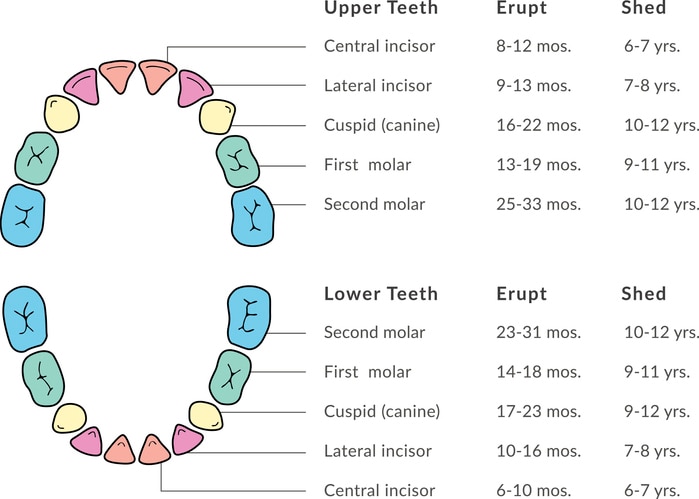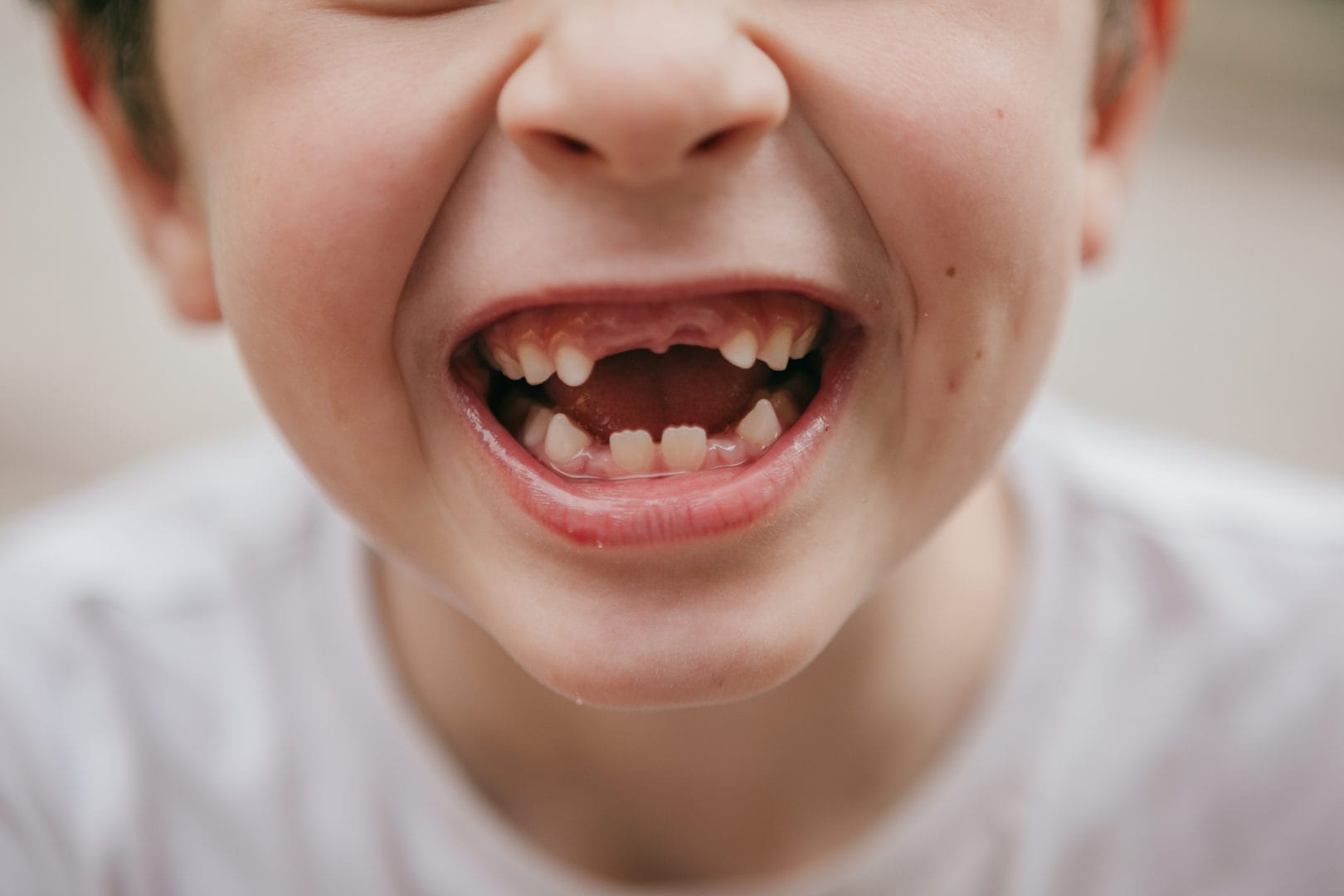You made it through the ups and downs of teething, and now you’re just trying to nail down creative ways to get a wriggly toddler to brush their new choppers every day. Then one day, your child’s first tooth feels a little wiggly or their peers start sporting adorable gap-toothed grins. Much like getting baby teeth, losing baby teeth is a big milestone for kids — and one that will earn them a visit from the tooth fairy to boot. Dive into this article to hear from experts about the timeline and sequence in which children typically lose their teeth.
“There is a range of ages that children exfoliate (lose) their primary teeth,” says Dr. Amr Moursi, dental surgeon and professor and chair of the NYU Department of Pediatric Dentistry. “I’ve had kids lose their first tooth between 4 1/2 and 5, and then I’ve seen 7- or even 8-year-olds who still haven’t lost any teeth.”
“I’ve had kids lose their first tooth between 4 1/2 and 5, and then I’ve seen 7- or even 8-year-olds who still haven’t lost any teeth.”
—Dr. Amr Moursi, dental surgeon
Wondering when your child may be tucking their pearly whites under their pillow? Here’s everything you need to know about losing baby teeth.
When do kids start losing teeth?
Most kids begin losing baby teeth around the ages of 5 and 6, according to Dr. Travis Nelson, a board-certified pediatric dentist, clinical associate professor and chair of the Department of Pediatric Dentistry at University of Washington. “Typically the first ones to get loose are the incisors of the lower jaw [the two central teeth on the bottom],” Nelson explains. “The next ones to fall out are usually the upper incisors [front teeth on top], which happens around age 8. And the baby molars are usually lost between 10 and 12 years old.”
“Typically the first ones to get loose are the incisors of the lower jaw.”
—Dr. Travis Nelson, pediatric dentist
While most kids lose their first tooth between the ages of 5 and 6, keep in mind, there is wiggle room, so to speak, based on every individual child. Additionally, keep your child’s overall development in mind. “There’s a general connection to where kids are on the growth curve and tooth eruption and shedding,” Moursi says. “If a child is below or above the mean in height and weight, tooth development may follow suit.”
And even though most kids don’t lose any teeth before age 5, you may start to notice changes to your child’s smile at about age 4. “Around this time, your child’s facial structure will begin to noticeably change and grow,” notes Dr. Alene D’Alesio, pediatric dentist and chief of pediatric dentistry at University of Pittsburgh Medical Center Children’s Hospital. “As this happens, you may start to notice spaces between their teeth. This is a natural growth process that provides room for adult teeth to emerge.”
Why do baby teeth fall out?
According to Nelson, baby teeth fall out due to “a natural process that is associated with normal growth and development and that it is related to factors like growth of the adult teeth and the natural resorptive (dissolving) process that occurs between the baby tooth roots and the bone.” However, he adds, “the exact cause of tooth loss is a subject of some debate.”
What teeth do kids lose and in what order do they lose them?
While the timing of losing teeth can vary from child to child, Nelson notes that the pattern of tooth loss is pretty consistent for most kids. “Generally, it begins with loss of lower front teeth and progresses to the baby second molars falling out last,” he says.
After that, it’s usually the upper central incisors, followed by the upper and lower lateral incisors. Typically, the last baby teeth to fall out are the upper cuspid (canine), lower second molars and upper second molars.
Baby teeth chart

Tooth loss age chart (Baby teeth)
| Tooth | Age tooth is shed |
| Lower central incisors | 6 to 7 years old |
| Upper central incisors | 6 to 7 years old |
| Upper lateral incisors | 7 to 8 years old |
| Lower lateral incisors | 7 to 8 years old |
| Upper first molars | 9 to 11 years old |
| Lower first molars | 9 to 11 years old |
| Lower cuspid (canine) | 9 to 12 years old |
| Upper cuspid (canine) | 10 to 12 years old |
| Lower second molars | 10 to 12 years old |
| Upper second molars | 10 to 12 years old |
Note: While the above chart lists 10 types of teeth, keep in mind that there’s one of each per side, making for a total of 20 baby teeth that will ultimately fall out.
Do baby teeth hurt before they fall out?
While losing baby teeth may be a little uncomfortable for some kids, don’t worry. You’re not about to embark on Teething Part Deux. “Some children report discomfort when baby teeth become loose and when new adult teeth emerge (especially the permanent molars), but others are completely fine,” Nelson explains. “Pain is subjective, and the experience likely relates to the actual tooth condition, as well as the child’s temperament and personality.”
If there is any discomfort, it’s likely due to a tooth that’s been hanging on for a while, notes Moursi. “When kids leave a tooth hanging by a thread for a long time, food and bacteria may get trapped in the gums, causing them to become red and inflamed,” he says.
The best way to avoid this? Have your child turn and wiggle their tooth as much as possible, according to Moursi. (Also, pro tip: Don’t tie a string around the tooth and connect it to a doorknob — the tooth may get swallowed or aspirated.)
What if baby teeth are knocked out?
If there’s one thing every parent can agree on, it’s that kids can be wild. To that point, a knocked out baby tooth certainly isn’t unheard of. While parents can’t always prevent an accident from happening (no matter how many times they say “stop jumping on the bed”), they should have a family or pediatric dentist and their phone number at the ready. “Every kid should be seen by a dentist by age 1, with regular 6-month appointments,” Moursi says. “This way, when something happens, you have someone to call.”
“Every kid should be seen by a dentist by age 1, with regular 6-month appointments. This way, when something happens, you have someone to call.”
—Dr. Amr Moursi, dental surgeon
He adds: “If a baby tooth comes out completely, we don’t reimplant it,” he continues. “But if it fractures, that may be more urgent, so it’s important for parents to call their child’s dentist for guidance. If there’s trauma to a baby tooth, depending on the stage of the adult tooth, there may wind up being damage to the adult tooth — especially if it’s the front teeth.”
When to consult a dentist/doctor
If your child is still hanging on to their full baby smile when their friends are starting to sport patchy grins, it really isn’t cause for concern. On the flip side, in some cases, prematurely losing certain teeth can be an indicator of something else. “Teeth not falling out is never really an emergency,” notes Nelson. “It is something that parents can discuss with the dentist at regularly scheduled exam visits.
On the other hand, very early loss of primary molars and canines (4 or 5 years old) can sometimes be related to genetic issues or disease in the tooth. If parents notice back teeth becoming loose, especially if there is pain or swelling, they should contact the dentist for advice.”






